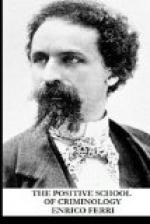When Cesare Beccaria printed his book on crime and penalties in 1774 under a false date and place of publication, reflecting the aspirations which gave rise to the impending hurricane of the French revolution; when he hurled himself against all that was barbarian in the mediaeval laws and set loose a storm of enthusiasm among the encyclopedists, and even some of the members of government, in France, he was met by a wave of opposition, calumny and accusation on the part of the majority of jurists, judges and lights of philosophy. The abbe Jachinci published four volumes against Beccaria, calling him the destroyer of justice and morality, simply because he had combatted the tortures and the death penalty.
The tortures, which we incorrectly ascribe to the mental brutality of the judges of those times, were but a logical consequence of the contemporaneous theories. It was felt that in order to condemn a man, one must have the certainty of his guilty, and it was said that the best means of obtaining tins certainty, the queen of proofs, was the confession of the criminal. And if the criminal denied his guilt, it was necessary to have recourse to torture, in order to force him to a confession which he withheld from fear of the penalty. The torture soothed, so to say, the conscience of the judge, who was free to condemn as soon as he had obtained a confession. Cesare Beccaria rose with others against the torture. Thereupon the judges and jurists protested that penal justice would be impossible, because it could not get any information, since a man suspected of a crime would not confess his guilt voluntarily. Hence they accused Beccaria of being the protector of robbers and murderers, because he wanted to abolish the only means of compelling them to a confession, the torture. But Cesare Beccaria had on his side the magic power of truth. He was truly the electric accumulator of his time, who gathered from its atmosphere the presage of the coming revolution, the stirring of the human conscience. You can find a similar illustration in the works of Daquin in Savoy, of Pinel in France, and of Hach Take in England, who strove to bring about a revolution in the treatment of the insane. This episode interests us especially, because it is a perfect illustration of the way traveled by the positive school of criminology. The insane were likewise considered to blame for their insanity. At the dawn of the 19th century, the physician Hernroth still wrote that insanity was a moral sin of the insane, because “no one becomes insane, unless he forsakes the straight path of virtue and of the fear of the Lord.”
And on this assumption the insane were locked up in horrible dungeons, loaded down with chains, tortured and beaten, for lo! their insanity was their own fault.




